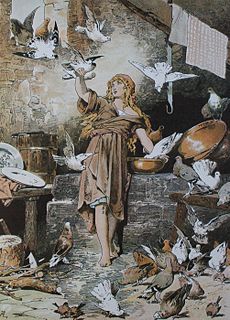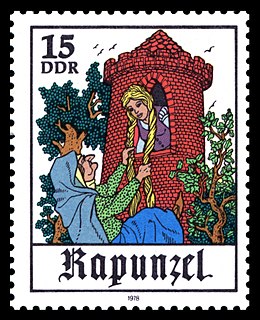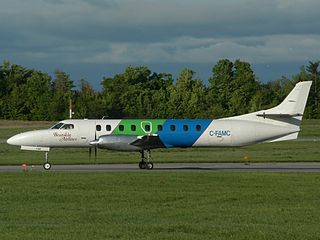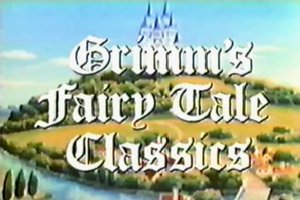See also
| | This disambiguation page lists articles associated with the title Bearskin. If an internal link led you here, you may wish to change the link to point directly to the intended article. |
A bearskin is a tall fur cap.
Bearskin may also refer to:
| | This disambiguation page lists articles associated with the title Bearskin. If an internal link led you here, you may wish to change the link to point directly to the intended article. |

The Brothers Grimm, Jacob Ludwig Karl Grimm (1785–1863) and Wilhelm Carl Grimm (1786–1859), were German academics, philologists, cultural researchers, lexicographers and authors who together collected and published folklore during the 19th century. They were among the first and best-known collectors of German and European folk tales, and popularized traditional oral tale types such as "Cinderella", "The Frog Prince", "The Goose-Girl", "Hansel and Gretel", "Rapunzel", "Little Red Riding Hood", "The Wolf and the Seven Young Goats", "Rumpelstiltskin", "Sleeping Beauty", and "Snow White". Their classic collection, Children's and Household Tales, was published in two volumes—the first in 1812 and the second in 1815.

A fairy tale, fairytale, wonder tale, magic tale, fairy story or Märchen is an instance of a folklore genre that takes the form of a short story. Such stories typically feature entities such as dwarfs, dragons, elves, fairies, giants, gnomes, goblins, griffins, mermaids, talking animals, trolls, unicorns, or witches, and usually magic or enchantments. In most cultures, there is no clear line separating myth from folk or fairy tale; all these together form the literature of preliterate societies. Fairy tales may be distinguished from other folk narratives such as legends and explicit moral tales, including beast fables.

"Cinderella", or "The Little Glass Slipper", is a folk tale about unjust oppression and triumphant reward. Thousands of variants are known throughout the world. The protagonist is a young woman living in forsaken circumstances that are suddenly changed to remarkable fortune, with her ascension to the throne via marriage. The story of Rhodopis, recounted by the Greek geographer Strabo sometime between around 7 BC and AD 23, about a Greek slave girl who marries the king of Egypt, is usually considered to be the earliest known variant of the Cinderella story.

"Sleeping Beauty", or "Little Briar Rose", also titled in English as "The Sleeping Beauty in the Woods", is a classic fairy tale about a princess who is cursed to sleep for a hundred years by an evil fairy, to be awakened by a handsome prince at the end of them. The good fairy, realizing that the princess would be frightened if alone when she awakens, uses her wand to put every living person and animal in the palace asleep, to awaken when the princess does.

An ogre is a legendary monster usually depicted as a large, hideous, man-like being that eats ordinary human beings, especially infants and children. Ogres frequently feature in mythology, folklore, and fiction throughout the world. They appear in many classic works of literature, and are most often associated in fairy tales and legend with a taste for infants.

"Bluebeard" is a French folktale, the most famous surviving version of which was written by Charles Perrault and first published by Barbin in Paris in 1697 in Histoires ou contes du temps passé. The tale tells the story of a wealthy man in the habit of murdering his wives and the attempts of one wife to avoid the fate of her predecessors. "The White Dove", "The Robber Bridegroom" and "Fitcher's Bird" are tales similar to "Bluebeard". The notoriety of the tale is such that Merriam-Webster gives the word "Bluebeard" the definition of "a man who marries and kills one wife after another," and the verb "bluebearding" has even appeared as a way to describe the crime of either killing a series of women, or seducing and abandoning a series of women.

"Hansel and Gretel" is a German fairy tale collected by the Brothers Grimm and published in 1812 in Grimm's Fairy Tales.

"Little Red Riding Hood" is a European fairy tale about a young girl and a Big Bad Wolf. Its origins can be traced back to the 10th century to several European folk tales, including one from Italy called The False Grandmother. The two best known versions were written by Charles Perrault and the Brothers Grimm.

Rapunzel is a German fairy tale recorded by the Brothers Grimm and first published in 1812 as part of Children's and Household Tales. The Brothers Grimm's story is an adaptation of the fairy tale Rapunzel by Friedrich Schulz (1790) that was a translation of Persinette (1698) by Charlotte-Rose de Caumont de La Force, which was itself influenced by an earlier Italian tale, Petrosinella (1634), by Giambattista Basile.

Bearskin Lake Air Service LP, operating as Bearskin Airlines, is a regional airline based in Thunder Bay, Ontario, Canada. It is a division of Perimeter Aviation and operates services in northern Ontario and Manitoba. Its main base is at Thunder Bay International Airport (YQT), with a hub at Greater Sudbury Airport (YSB).

In fairy tales, a fairy godmother is a fairy with magical powers who acts as a mentor or parent to someone, in the role that an actual godparent was expected to play in many societies. In Perrault's Cinderella, he concludes the tale with the cynical moral that no personal advantages will suffice without proper connections.
Jack David Zipes is a professor emeritus of German, comparative literature, and cultural studies, who has published and lectured on German literature, critical theory, German Jewish culture, children's literature, and folklore. In the latter part of his career he translated two major editions of the tales of the Brothers Grimm and focused on fairy tales, their evolution, and their social and political role in civilizing processes. According to Zipes, fairy tales "serve a meaningful social function, not just for compensation but for revelation: the worlds projected by the best of our fairy tales reveal the gaps between truth and falsehood in our immediate society." His arguments are avowedly based on the critical theory of the Frankfurt School and more recently theories of cultural evolution.

Grimm's Fairy Tale Classics, also known as Grimm Masterpiece Theater in the original version, is a Japanese anime anthology series by Nippon Animation. The episodes are adaptations of a variety of folk and fairy tales, and, despite the name, not limited to Grimm's Fairy Tales.

"Bearskin" is a fairy tale collected by the Brothers Grimm. A variant from Sicily, "Don Giovanni de la Fortuna", was collected by Laura Gonzenbach in Sicilianische Märchen and included by Andrew Lang in The Pink Fairy Book. Italo Calvino included another Italian version, "The Devil's Breeches" from Bologna, in his Italian Folktales.
The Gold-Children is a German fairy tale collected by the Brothers Grimm, tale number 85. It is Aarne-Thompson type 555, the fisherman and his wife, followed by type 303, blood brothers.
The Bear is a fairy tale collected by Andrew Lang in The Grey Fairy Book. It is Aarne-Thompson classification system type 510B, unnatural love. Others of this type include Cap O' Rushes, Catskin, Little Cat Skin, Allerleirauh, The King who Wished to Marry His Daughter, The She-Bear, Tattercoats, Mossycoat, The Princess That Wore A Rabbit-Skin Dress, and Donkeyskin, or the legend of Saint Dymphna.
Bearskin is a French literary fairy tale by Marie-Madeleine de Lubert. It was included in her revised edition of Henriette-Julie de Murat's last novel, Les Lutins du château de Kernosy.

A goblin is a monstrous creature that appears in the folklore of multiple European cultures, first attested in stories from the Middle Ages. They are ascribed various and conflicting abilities, temperaments and appearances depending on the story and country of origin. They are almost always small and grotesque, mischievous or outright malicious, and greedy, especially for gold and jewelry. They often have magical abilities similar to a fairy or demon. Similar creatures include brownies, dwarfs, duendes, gnomes, imps, and kobolds.
Der Bärenhäuter is an East German movie from the year 1986, based on the fairy tale Bearskin.
Der Bärenhäuter may refer to: